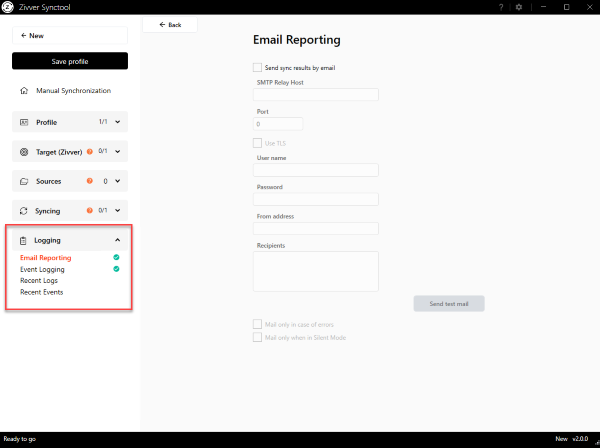I am a Zivver admin
Configure and manage Zivver
09. Synctool Logging

Introduction
This section describes how to customize event logging, view recent logs and events or set up automated log digests by email. These functions are grouped under the Logging tab in the Synctool user interface.
The Zivver Synctool performs a mock synchronization before it does an actual synchronization. The mock synchronization could be causing log or event entries for a specific user to appear twice.
Email Reporting
At Email Reporting set up an automated email report, so that you receive updates in your mailbox from Synctool synchronizations. Zivver recommends setting up email reporting as this notifies the administrator of any synchronization errors without having to log in to the Synctool server to look for errors in the synchronization logs.
You decide by checking the corresponding boxes if you only want to receive email reports in case of errors or every time the Synctool was run scheduled and unattended.
By default no email report is sent, therefore the first step is to check the box at Send sync results by email.
- SMTP Relay Host
This is the Host Name of the SMTP Relay Host, for examplesmtp.example.orgorsmtp.office365.comor the IP Address of the relay host. This is a mandatory field.Tip
Use Microsoft 365 documentation for more in-depth information
How to set up a multifunction device or application to send email using Microsoft 365 or Office 365 - Port
This port will be used for SMTP traffic. Fill in587(recommended) or use port25. This is a mandatory field. - Use TLS
Check the box at if you want to use TLS. - User name
If you need to authenticate towards the SMTP Relay Host, then fill in the username for authentication. This may not be necessary. - Password
If you need to authenticate towards the SMTP Relay Host, then fill in the password associated with the username for authentication. This may not be necessary. - From Address
Enter an email address that will be the sender of the email reports. This can be a fictional address, such assynctool@your-organization-domain.com. This is a mandatory field. Recipients will receive the email reports from this (fictional) address. - Recipients
Enter the email address that should receive the report. This can be a personal or shared mailbox. If you want to add multiple addresses, separate them by a semi-colon;or add each new address on a new line. This is a mandatory field. - Send test mail
Send a test mail to test if you can send a message from the Synctool server to the recipients.Note
If the test email fails
If the test email failed, please consult your Exchange administrator or documentation on your mail server on how to relay SMTP messages. - Mail only in case of errors
Check this box if you only want to be emailed when an error occurs during synchronization. Zivver recommends enabling this feature. - Mail only when in Silent Mode (recommended)
Check this box if you want to be emailed when the Synctool was run scheduled and unattended. For example by the Windows Task Scheduler.
Event Logging
At Event logging you enable the options to write events to a file, Windows Events Log and create an Event summary.
Write events to a file
Enable Write events to file and specify a folder by clicking . The log file will contain a status of how an account is processed during that synchronization.
Best practice is to store the event files where you have stored the Synctool. For example, if you have stored the Synctool at
C:\Program Files\Zivver.Synctool, then create a folder called Logs. So that you can save the event logs in C:\Program Files\Zivver.Synctool\Logs.If you enable Write events to file but do not specify a folder, then event files will be written to the folder that contains the Synctool profile.
If you do not enable Write events to file, then no event file will be saved after running a synchronization.
Write events summary to a file
Enable Write events summary to file and specify a folder by clicking . The summary only contains the amount of mutations done, how many were successful and how many failed.
Best practice is to store the summaries of events where you have stored the event logs. For example, if you have stored the logs at
C:\Program Files\Zivver.Synctool\Logs, then create a folder called Summary. This is so you can save the summary event logs in C:\Program Files\Zivver.Synctool\Logs\Summary.If you enable Write events summary to file but do not specify a folder, then event files will be written to the folder that contains the Synctool profile.
If you do not enable Write events summary to file, then no event file will be saved after running a synchronization.
Write events to Windows Event Log
Enable Write events to the Windows Events Log if you already monitor Windows Events in a third party application (e.g. Splunk) and want to monitor Synctool events in your third party application.
Recent Logs
At Recent Logs you can find in-depth logs about background Synctool processes. If you run into any synchronization issues, you can find the corresponding logs in this tab. The logs are sorted on six different levels:
- Trace
- Debug
- Warning
- Error
- Fatal
The Zivver Synctool application logs are stored in
%AppData%\Zivver\SyncTool\Logs. The file name is called zivver_synctool_app.log and this file should not exceed 50 MB in size. If 50 MB is reached for zivver_synctool_app.log, then a new log file will be created and the current file will be renamed to zivver_synctool_app.log.bck. The zivver_synctool_app.log.bck file will be overwritten when zivver_synctool_app.log reaches 50 MB in size again.Recent Events
At Recent Events you can see background Synctool processes for the last action executed, such as manual synchronizations, preview changes or preview sources.
The items shown in the Recent Events contain information about loading, parsing and sanitizing source data. The Recent Events can help you identify where in a process something could have gone wrong.
